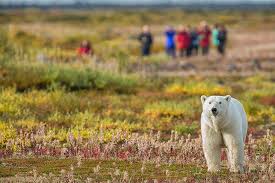
Polar bears are wild creatures. They roam widely, with some having been tracked to a home range of over 6.000,000 square km. One individual was found more than 4000km from where it was before.
Its not even an issue of just giving them a large reserve, as they spend the cold winters roaming far and wide across the worlds oceans. Even in a country like Canada or Greenland, it is not possible to exclude humans from that much land.
This has been a problem over the years, for those who settled in places like northern Canada. Of course the native Inuit people had lived in a relatively happy coexistence with the polar bear, but as climate change continues and the bears are forced to spend longer and longer on land, these conflicts have become more common and more dangerous. As the ice melts earlier and earlier, the polar bears are forced onto to land that once surrounded the frozen sea. These bears spend longer and longer on this land. In the past, while polar bears will eat any time that an opportunity occurs, this part of the year would have been a time of fast – living off the copious fat deposits that had been laid down, while hunting seal out on the ice. They are not well suited to long chases across land, like the arctic wolves (they are effective ambush predators, where there is enough cover, or plenty of snow, for them to blend in to). However, opportunities to hunt on land are often not common, forcing the bears to head towards human settlements – where both rubbish and raiding of homes can give the bear an easy meal. While in the past, they would have spent more time out on the ice, the Southern edge of their range only has ice for 6-7 months of the year. Assuming that we do not manage to halt climate change in the next few years, some populations of polar bears, will find themselves staying on land for longer than they can survive without eating.
This is leading to the bears becoming more comfortable around humans and harder to scare off.
Fishermen, and jobs like radar technician are becoming more dangerous as it is one thing to occasionally encounter a polar bear, but it is quite another to be a polar bears prey, and have to contend with being actively hunted. Of the estimated 22,000 – 31,000 wild polar bears which remain, as many as 17,000 consider Canada as home (this is a rough figure).
Given that there are this many polar bears, one would expect more conflict, but thankfully at the current time, conflict is rare – however, if these bears are forced to stay on land for longer and longer, they are going to find other means of eating. Unfortunately, this summer showed another problem. While almost record lows of ice were available, there was still significant ice in western Hudson bay, however, while being thick it did not develop the ridges and snow that is normally there, which meant that few ringed seals successfully bred , and therefore there was little food to be had.
As recently as the 1980s (when I was born) polar bears would look like “giant fat sausages” lying on the beach during the summer. Nowadays, while in good seasons the bears are not slim, they rarely manage to build up this large store. Each settlement generally has the right to hunt a few bears, though clashes are occurring even on this. Inuit are seeing polar bears more often, so they believe that they should be able to hunt more bears, yet, this is not a sign of a growing bear population, merely the food situation that has hit them.
It also can potentially make it harder for tourism, as with changing behaviour patterns comes a difficulty in predicting where the bears will be. Different places around the north pole, have varying quantities of polar bear tourism, but we want the polar bears to survive long-term. I hope to be able to list places for this fascinating species to be seen as soon as possible.











